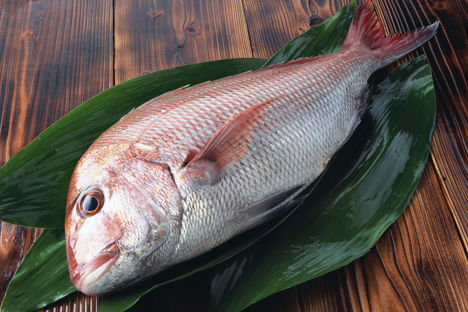
Seafood of Japan: tai (sea bream)
With a versatility that lends itself to grilling, roasting, curing and baking, and a sweetness that makes it perfect for sashimi, sea bream is a staple food in Japanese cuisine. Historically viewed as a symbol of luck, it’s also a centrepiece for special occasions and at the heart of the country’s cultural heritage.
Seafood of Japan: tai (sea bream)
With a versatility that lends itself to grilling, roasting, curing and baking, and a sweetness that makes it perfect for sashimi, sea bream is a staple food in Japanese cuisine. Historically viewed as a symbol of luck, it’s also a centrepiece for special occasions and at the heart of the country’s cultural heritage.
Sea bream is an incredibly important fish in Japan, both a staple in home cooking and a celebrated part of feasts at special occasions. Its firm texture and mild flavour make it well-suited to that range, but its significance in Japan goes beyond its culinary attributes; nicknamed the king of fish, it has long been viewed as a symbol of good luck, its image used in festivals and traditional gatherings. Mainly caught off the country’s west coast, sea bream is unsurprisingly eaten most often in western parts of the country, including Kyushu, Kyoto and Osaka, though it’s enjoyed all over the country, as well as in Taiwan, Korea and further afield. There are many species of fish which have ‘tai’ (meaning sea bream) in their name, but there are four main species (madai, chidai, kidai and kurodai), three of which are red-bodied and can be difficult to tell apart to the untrained eye. Madai – translating as ‘true sea bream’ – is often viewed as the crown jewel of the species.
Red sea bream’s links with luck span back as far as 1,300 years, when it was given as a ritual offering to gods at shrines – it’s also said that tai rhyming with ‘medetai’, which can be translated as happy or good news in Japanese, has further supported its status as a fish fit for a celebration. It’s often served whole at New Year celebrations and okuizome, a traditional ritual which takes place 100 days after the birth of a baby, while at weddings, the bride and groom sometimes crack open a salt-crusted tai with a wooden hammer. The sea bream motif also features in cultural events; there are whole festivals dedicated to tai, as well sea bream-shaped floats and lanterns and even taiyaki (waffle desserts shaped like fish).
Although it’s at the heart of many special occasions, sea bream’s versatility means it’s also a staple part of the Japanese diet. It has a firm and lean texture, with a neutral but slightly sweet, umami flavour, and it holds up well to most cooking methods, including grilling, steaming, pan-frying and baking. In Japan, it’s widely eaten raw in sashimi and sushi, baked in salt or grilled. One popular dish is tai-meshi, sea bream with rice (you can see Endo Kazutoshi’s recipe here), of which there are many interpretations; it can be cooked in konbu dashi stock, grilled whole or even marinated in beaten egg and served as sashimi, for example. Tai-somen, meanwhile, is a similar dish which uses noodles instead, while ushio-jiru is a simple soup which is seasoned only with salt and sake, which was originally eaten by the fishermen who caught tai. It’s also sliced thinly and used in shabu-shabu, a Japanese hotpot, while young sea bream are served dressed with vinegar. In China, it’s often steamed, and elsewhere around the world, it features in carpaccios, paellas and acqua pazza.
Generally, tai can be cooked in the same way as most white fish, including, of course, other types of sea bream (sometimes called gilt-head bream in the UK) – you can see our how to cook guide here. Try wrapping it in baking paper and foil and cooking it in the oven, grilling it on the barbecue or under a hot grill, or steaming it, to protect its delicate flesh. It has a largely neutral flavour, which means it can hold up to flavours both mild and robust; try pairing it with other Japanese flavours such as soy, dashi or sake. It also has a high nutrient content, including B vitamins, calcium and zinc.
Historically an underrated fish, sea bream has been increasingly appearing on restaurant menus in the UK over the last few years. It’s no wonder that chefs in kitchens across Japan have long made the most of such a versatile fish, which is brimming with potential.


